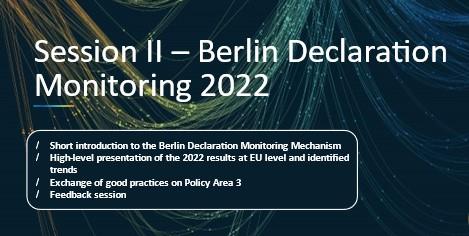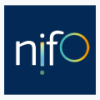On 27 June 2023, the National Interoperability Framework Observatory (NIFO) team held an online webinar gathering the National Contact Points of European countries, together with other stakeholders from both the public and private sectors to discuss the results of the 2022 editions of the European Interoperability Framework (EIF) and Berlin Declaration (BDM) Monitoring Mechanisms and hear from the experience of four EU countries in the fields of cross-border interoperability, empowerment, and digital literacy.
The webinar was divided into two sessions, the first one being dedicated to the EIF, and the second one to the BDM.

During the first part of this session, a short presentation of the key elements of the EIF and its monitoring mechanism was given as well as a high-level presentation of the 2022 results of the EIF monitoring mechanism at the EU level. This was followed by a deep dive into the results at recommendation level and identified trends.
It appears that, overall, there is a good implementation among Member States of the EIF recommendations for the four scoreboards:
- Scoreboard 1 – Interoperability Principles: Eight out of twelve principles have reached the highest score of 4 in 2022. Compared to 2021, European countries have mainly improved their level of implementation of Principle 1 (Subsidiarity and Proportionality). Potential areas of improvement are related to the principles of Inclusion and Accessibility (Principle 7), Multilingualism (Principle 9) and Assessment of effectiveness and efficiency (Principle 12).
- Scoreboard 2 – Interoperability Layers: There is also a high level of implementation of the EIF’s interoperability layers at EU level, with five out of six areas reaching the highest score of 4. Nonetheless, it is important to note that, in 2021, European countries had already reached the highest scores for the majority of the interoperability layers. The only area of improvement for the future is related to the layer of interoperability governance, for which the score of 3 could be further improved.
- Scoreboard 3 – Components of the EIF Conceptual Model: Similarly to 2021, the 2022 results of the EIF monitoring mechanism show that European countries are scoring maximum points in four components of the EIF conceptual model. The results of 2022 demonstrate the countries’ dedication to further enhance data reuse, access, and openness, which are fundamental drivers for interoperability.
- Scoreboard 4 – Cross-border interoperability: Overall, all cross-border components have received high scores at EU level in 2022, with a particular focus by the European countries on initiatives related to the interoperability layers. European countries could improve their level of cross-border interoperability by focusing particularly on initiatives related to the 12 Principles of the EIF, in particular with regard to Recommendation 9 on data portability, Recommendation 14 on accessibility, Recommendation 23, related to the use of ICT catalogues, and Recommendation 47 as regards the number of trust service providers.
We then had the pleasure to welcome two guest speakers, Ana Rosa Guzmán Carbonell, from the Spanish Ministry of Economic Affairs and Digital Transformation, and Mattias Ekhem, from Sweden’s Agency for Digitalisation (DIGG), who presented good practices and insights on how cross-border interoperability is tackled and addressed in their respective countries. Their presentations were followed by a panel discussion between the speakers and the audience, particularly on the challenges faced, lessons learned, and potential EU support that could further enhance cross-border interoperability at national level.
More information on the presentations and answers provided by the speakers is available in the slide-deck presentation below.

During this second session, a short presentation of the key elements of the Berlin Declaration and its monitoring mechanism was given as well as a high-level overview of the 2022 results of the monitoring mechanism at the EU level, in particular the main trends with regard to the three most progressing Policy Areas (Policy Area 1, Policy Area 3 and Policy Area 6).
It appears from the 2022 data collection that all Policy Areas, at EU average level, are experiencing a positive growing trend – although some at a slower pace than others – except Policy Area 2 where a slight decrease of 1 percentage point compared to last year can be discerned. Interestingly, important progress has been identified in the following Policy Areas compared to last year:
- Policy Area 1 - Promote fundamental rights and democratic values in the digital sphere: There has been an increase of 12 percentage points compared to 2021, at the EU average level, for this Policy Area. It is thus the best-performing Policy Area in 2022, as it recorded the highest score and highest increase among all Policy Areas, at EU average level. 24 out of 27 Member States improved their implementation status in this Policy Area and considered the topic of fundamental rights and democratic values in the digital sphere as a top priority for the year 2022-2023.
- Policy Area 3 - Foster digital empowerment and digital literacy: This Policy Area follows a positive growing trend, with an increase of 5 percentage points compared to 2021, at EU average level. Member States might have been incentivised to act in this Policy Area with the launch, in April 2022, of a Skills and Talent Package by the European Commission. Additionally, Member States have introduced new strategies and initiatives (including trainings) to increase their citizens’ and businesses’ digital skills and competencies.
- Policy Area 6 - Create value-based, human-centred AI systems for use in the public sector: This Policy Area follows an encouraging trend, with an increase of 10 percentage points compared to 2021, at EU average level. This evolution can be linked to the adoption of the proposal for an Interoperable Europe Act, as one of its key pillars is to develop new skills and scale up interoperability solutions for reuse. Finally, the adoption of new regulations and initiatives at EU level (such as the Digital Services Act, the AI Act, and the AI Watch) has contributed to the growing implementation level of this Policy Area.
More detailed information on those signs of progress is to come in the soon-to-be-published second edition of the BDM Report.
We then had the pleasure to welcome two guest speakers, Maria Deredaki, from the Greek Ministry of Digital Governance and Frank Leyman, from the Belgian Digital Transformation Office (BOSA), who provided insights on the initiatives implemented within their countries on the topic of empowerment and digital literacy. Their contributions were followed by a panel discussion on the same topic, which dug more closely into the challenges faced and lessons learned when tackling the topic of digital skills and digital literacy in their respective countries, as well as concrete measures to ensure that people from disadvantaged backgrounds also have access to digital skills trainings and that all citizens are empowered to manage their digital identity and to protect their personal data and privacy online.
More information on the presentations and answers provided by the speakers is available in the slide-deck presentation (please see the link at the end of this article).
Finally, the last part of both sessions was dedicated to collecting feedback on how to improve the next editions of the data collection exercise.
For further details, the slide-deck presentation with Q&A is available below and the recording of the webinar is available here.
On behalf of the NIFO team:


